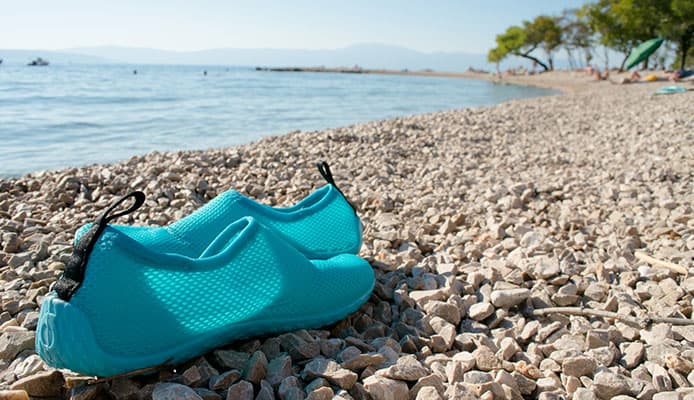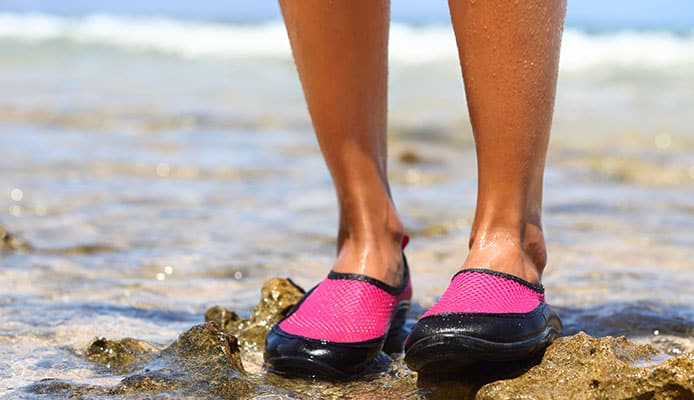
Rocking the right footwear when venturing into water sports is just as important as bringing the right gear. Whether you are going surfing, kayaking, or just walking lazily on the nearby beach, your feet need proper protection.
But won’t any shoe be fine in the water? You may ask! Well, the truth is, not all shoes are designed for the marine environment. For instance, you can’t bring your hiking shoes on a boating adventure. You need to get something flexible, lightweight, and most importantly something that you won’t mind getting drenched, and this is where water shoes come in. You really don’t need a dry bag or special gear to carry these – just strap them on and you are good to go!
Water shoes provide the ideal comfort and safety to your feet. If you have ever stamped on a sharp object buried in the beach sand with bare feet, then you already know why protecting your feet matters.
Related Review: Water Shoes
But What Exactly Are Water Shoes?
As the name suggests, water shoes are simply shoes designed for water-related activities. They are mainly worn to keep the feet from harm while swimming in the lake, sea, or dam, crossing a river, walking on the beach, and much more. If you are adventuring with kids, get a pair for them too. The market has plenty of water shoes for toddlers and kids that can fit those tiny tootsies.
The way these types of shoes are designed is that they have a hard, thick, and flexible sole that protects your feet from gravel, sand, and sharp rocks. They are perfect for almost all water sports and if you are hiking on a trail that has plenty of water hazards, these will keep your feet safe. In simpler terms, whatever kind of outdoor adventure you fancy, whomever you are going with, water shoes can save your entire trip from a foot tragedy, literally.
But what are water shoes for if your feet will still get damp anyway?
Good question! Water shoes are not meant to be waterproof. In fact, apart from the sole, all the other parts are basically made of mesh or another quick drying lightweight material to allow for ventilation. If you want to keep your feet dry, then you may want to try water socks.
Water shoes that are well ventilated can be washed and dried easily, which protects you from smells and bacteria that accompany wet shoes and feet. This also reduces risks of highly contagious conditions like athlete’s foot.
Why You Need A Pair Of Water Shoes
As we have just stated, the biggest reason why every outdoor enthusiast invests in water shoes is protection. Whether you are wading through cloudy waters, playing on a rocky riverbank, or collecting seashells on the beach, water shoes will keep your feet out of danger. Here are more perks of rocking a pair:
Traction
If you are walking on slippery surfaces like smooth rocks, boat decks, and docks barefoot, there are high chances of you falling and getting hurt badly. Water shoes come with a strong rubber outsole and putting a pair on when wading through these greasy surfaces will provide optimal support and traction and enhance stability.
The reason why you are taking a trip to the great outdoors is to have fun and to achieve this, you need to keep accidents resulting from slipping minimal. Lace-up or slip-on water shoes will be perfect in this regard. Just make sure they provide a firm grip and excellent ankle support.
Lightness
There is one problem with wearing your usual hiking boots or trail running shoes when undertaking a water sport – these can get quite heavy when soaked. This may slow you down if you are taking part in an activity that requires swift movements. That’s not even the worst part. The retained water can make your feet feel squishy and uncomfortable, which could lead to foul smell or painful blisters.
Comfort And Breathability
Most water shoes come with compressed midsoles to provide comfort when engaged in water-related activities. The vented upper design increases breathability and enables faster drying, which allows you the freedom to jump into the water and have the best moments with the sea, lake, or river without worrying about drying your shoes later. To increase comfort, consider investing in a pair with excellent heel cushioning.
Still, wondering what are water shoes used for?
Probably you haven’t heard that breathability keeps your water shoes well-drained, something you need while out there. You really can’t go wrong with highly breathable and comfortable water shoes when heading out for water sporting activities.
How To Get The Most Out Of Your Water Shoes
The secret to getting the most out of your water shoes is investing in the right pair. Depending on the activity you intend to venture into, you can go for either lace-ups or slip-on.
If you are going sailing, swimming, or taking a stroll on the beach, then a slip-on design will be a great option. For fishing, hiking, or boating, lace-ups will be perfect. For improved security and easier adjustability, consider a design with a bungee cord lace. Below are different types of water shoes designed for different outdoor activities:
Sandals And Flip Flops
If you are looking for something that is suited for bumpy aquatic adventures, then this is it. Sandals and flip flops are designed for people who wish to protect their feet while biking, swimming, or running through rugged terrains.
There are various options to fit every gender. Usually, flip flops and sandals for men have an open toe and thick sole. Their strap lacing system allows you to tighten your shoes as necessary for enhanced comfort. Some even have a mesh lining around them to increase breathability and ventilation.
But women tend to be more sensitive than men and would probably go for added coverage and protection to their toes. It is for this reason that most women’s sandals will come with a toecap. However, a majority of flip flops for women will be open-toed. In fact, most of them will be just two straps and a sole.
Nevertheless, both open and closed toes will get the job done but for people with foot issues like corns and bunions, an open style will be more appropriate, as this will reduce chafing.
Five Toed Shoes
No better way to keep your feet safe but still experience the thrilling feeling of being barefoot than with a pair of five-fingered water shoes. A good pair will work perfectly on waterbeds, rivers, beaches, and any other wet ground.
These shoes are designed to adapt well to slippery surfaces, have an efficient drainage system, and are well vented. But different people have different toe lengths and widths so it is important to try the pair you intend to buy on to make sure it fits you snuggly and is comfortable to perform your activities in.
You might also like: Flip Flops For Women
Hiking Water Shoes
Hiking or active water shoes are designed for hikers, backpackers, trekkers, campers, or runners who fancy performing their activities on wet terrains. They are highly stable, durable, and well-cushioned, just like hiking boots and trekking shoes. The only difference is that hiking water shoes feature drainage holes on the soles to let water out of the shoe.
These are the best water shoes for men and women who love hiking or backpacking in the rain and need something that performs well in wet conditions.
Booties
Some people prefer water shoes that cover their ankles to provide even more comfort and support and this is where booties come in. Water shoes manufacturing companies offer various variations for booties, which works well for surfers, snorkelers, and paddlers. Some go up to the knees, others feature straps for extra comfort, while some emulate the five-toed barefoot look.
Booties provide extra insulation when maneuvering ice-cold water. They protect the tootsies from frostbites and getting cut or mangled. Depending on the style you like, you can choose a pair that works for you the best.
Boating Shoes
The basic sailing shoes may not be appropriate for all water-related activities but they can come in handy when boating or fishing. Imagine slipping and falling on the deck or getting poked on the toe by a fishing hook just because you decided to go out there barefooted or in sandals or flip-flops! Yes, these will keep your feet safe but may not offer the protection you need when boating.
Most boating shoes are made of leather or canvas and will cover a good part of your feet. They are therefore more suited for boat parties but not the best for walking on a rugged coast.
Globo Surf Overview
If you were wondering what are water shoes and how to get the most out of them, then we believe that by now you got your answer. Sure, water shoes may never make it to the cover of any fashion magazine but are an essential part of your outdoor gear. They keep your feet out of harm’s way and make your activities more enjoyable. So, next time you head out to the beach or trailhead, make sure you have packed the right pair so you can have a more comfortable and fun-filled experience.
More Watergear Water Shoes Reviews:
More Shoes Reviews:


